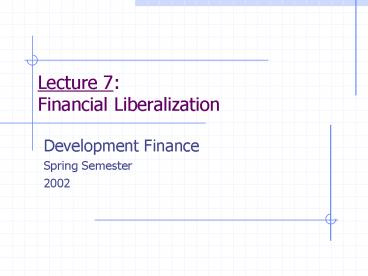Lecture 7: Financial Liberalization - PowerPoint PPT Presentation
1 / 11
Title:
Lecture 7: Financial Liberalization
Description:
Due to the decrease in loans available from the formal financial system, ... credit; while the prudent borrowers will be forced to leave the market (adverse selection) ... – PowerPoint PPT presentation
Number of Views:1554
Avg rating:3.0/5.0
Title: Lecture 7: Financial Liberalization
1
Lecture 7Financial Liberalization
- Development Finance
- Spring Semester
- 2002
2
Effects of Financial Repression(McKinnon Shaw
1973)
- Strict control over interest rates, high reserve
requirement coupled with inflation usually
leading to negative deposit rates ? impeding the
financial deepening process. - Low interest rates do not increase investment as
expected because the ability to mobilize savings
is limited. - Household and business investment tends to
concentrate on high-value inflation-free assets
(e.g. gold or real estate). - Due to the decrease in loans available from the
formal financial system, investors have to rely
more on self-finance. - Reliance on self-finance reduces the liquidity of
business liabilities. - Investment activities of insurance companies and
investment funds are constrained once the
currency becomes unstable and financial assets
are illiquid. - Directed credit schemes accompanied by other
preferential interest rates create a wide
disparity in interest rates between the favored
and non-favored groups.
3
Financial Repression
With this policy of interest rate control,
investment I0 is lower than the equilibrium
investment at E.
- Savings S0 corresponding to the economic growth
rate g0 are a function of the real interest rate.
- The line FF represents the nominal interest rate
ceiling causing the real deposit rate to remain
below the equilibrium. - Real investment I0 is equal to the amount of
savings at the real interest rate r0.
4
Financial Liberalization
- The interest rate ceiling is increased from FF to
FF. - The growth rate increases from g0 to g1.
- Savings shift to the right from S0 to S1.
- Investment increases to I1.
- Control over interest rates is totally removed,
savings moves to S2 corresponding to the growth
rate g2. The equilibrium is now E2. The real
interest rate is r2 and investment is I2.
5
Critics of Financial Liberalization
- The New Structuralists
- The deregulation in the formal financial market
will increase the deposit rate and therefore move
deposits away from the informal to the formal
market. - Banks are subject to the reserve requirement on
savings deposits, while lenders in the informal
sector is not. - The transfer of deposits from the formal to the
informal market therefore reduces the total
capital available. - Market Failure
- The higher the returns on the loan, the higher
the proportion of risky borrowers applying for
credit while the prudent borrowers will be
forced to leave the market (adverse selection) - Any borrower will try to change the nature of
their project to make it more risky (moral
hazard). Because the expected return on the loan
of the prudent borrowers may not be high enough
to pay loan interest rates.
6
Financial Liberalization and Macroeconomic
Instability
- Financial liberalization through interest rate
deregulation and lower reserve requirement has
taken away an instrument for the government to
offset budget deficits. - If the government is unable to borrow from
domestic sources and yet does not want to
increase inflation tax, then the capital account
must be relaxed to access foreign savings and
finance the budget deficits. - Foreign capital inflows make the real exchange
rate appreciate. In fact, the exchange rate can
over-appreciate and gradually depreciates due to
the capital inflow decreasing over time once
foreign debts approach the level required by the
economy.
7
Financial Liberalization and Macroeconomic
Instability (Cont.)
Capital inflows make the exchange rate appreciate
Profits in the non-traded good sector increase
Profitsin the traded good sector decline
Current account deficits increase, financed by
foreign capital inflows.
Overvalued ER gets to the unsustainable level.
Capital flight occurs
The exchange rate is devalued
Profits in the non-traded good sector declines
Economic adjust-ment continues
But if the government still runs budget deficits,
then financial repression must be re-imposed.
8
Sequence of Financial Liberalization
Capital account reform
Reduce budget deficit
Trade reforms
Foreign Exchange Management
9
International Financial Liberalization
- Removing control over capital inflows and
outflows is called capital account
liberalization. - Benefits of Capital Account Liberalization
- Static benefits A reallocation of capital
investment from capital rich countries with low
returns into capital poor countries but with high
returns. - Dynamic benefits Providing opportunities for
risk diversification (domestic assets can be
incorporated into a wider international
investment portfolios), reducing the costs of
capital for domestic enterprises. - In addition, capital account liberalization often
goes with the import of foreign financial
services and therefore enhances the efficiency of
the domestic financial system.
10
International Financial Liberalization (Cont.)
- Costs of Capital Account Liberalization
- Capital account liberalization leads to financial
crisis. - The problem of information asymmetry is even more
serious in international financial markets due to
geographical, cultural and legal differences
which further complicate the collection of
information. - On the one hand, IT and telecommunications
shorten the economic distance and promote
trans-national financial transactions. - But on the other hand, international financial
markets are more strongly affected by reaction
from investors and unexpected market
fluctuations.
11
International Financial Liberalization (Cont.)
- Role of policy
- Research has yet to produce consistent empirical
evidence on whether complete capital account
liberalization has a positive or negative effect
on economic growth, poverty reduction and
economic stability. - Policy planning to minimize costs and maximize
benefits of international financial
liberalization is of paramount importance - and
can be an enormous challenge. - Areas that need special attention are
macroeconomic policies, prudent regulations
applicable to banks as well as non-bank financial
institutions, accounting-auditing practices and
bankruptcy laws.































